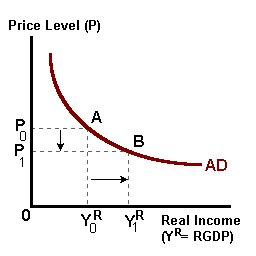
Aggregate demand is a measure the ability to spend or a level of expenditure used to command varying quantities of goods and services at different price levels. This concept is a measure of purchasing power such that when prices increase (at the overall price level) with a given level of nominal income, fewer goods or services can be purchased.
In understanding the behavior of aggregate demand we must take a close look at its individual components:
Nominal Income = (Ct + It + Gt + NXt)
For a given level of nominal expenditure, an inverse relationship exists between the price level 'P' and Real Income 'YR'. Aggregate demand represents this inverse relationship between the price level and a given level of purchasing power in an economy.
AD: {Pt × YRealt = Ct + It + Gt + NXt}
or
YRealt = YtNominal/Pt

Any factor that affects consumption, investment, government, or export-import expenditure will translate into a change in nominal expenditure and, at an existing price level, a change in purchasing power. These factors may include changes in interest rates, exchange rates, wealth, taxes, public spending, expectations, or monetary policy targets. All can lead to inward shifts (smaller nominal expenditure) or outward shifts (larger nominal expenditure) of the aggregate demand curve. These shifts models change in the ability to spend in the aggregate economy.